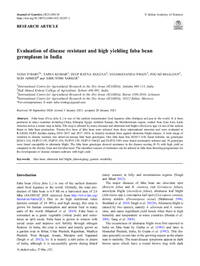Evaluation of disease resistant and high yielding faba bean germplasm in India

Authors:
Faba bean (Vicia faba L.) is one of the earliest domesticated food legumes after chickpea and pea in the world. It is been produced in many countries including China, Ethiopia, Egypt, northern Europe, the Mediterranean region, central Asia, East Asia, Latin America and as a minor crop in India. The crop is affected by many diseases and alternaria leaf blight (Alternaria spp.) is one of the serious threat to faba bean production. Twenty-five lines of faba bean were selected from three international nurseries and were evaluated at ICARDA-FLRP-Amlaha during 2016–2017 and 2017–2018, to identify resistant lines against alternaria blight disease. A wide range of variation to disease reaction was observed among faba bean genotypes. One faba bean line (S2011-134) found tolerant, six genotypes (S2011-116, FLIP15-139, FLIP15-156, FLIP15-159, FLIP15-164-S2 and FLIP15-169) were found moderately tolerant and 16 genotypes were found susceptible to alternaria blight. The faba bean genotypes showed resistance to the disease scoring (0–9) with high yield as compared to the checks, Giza and Gwalior local. The identified sources of resistance can be utilized in faba bean breeding programmes for the development of disease tolerant cultivars with high yield.
